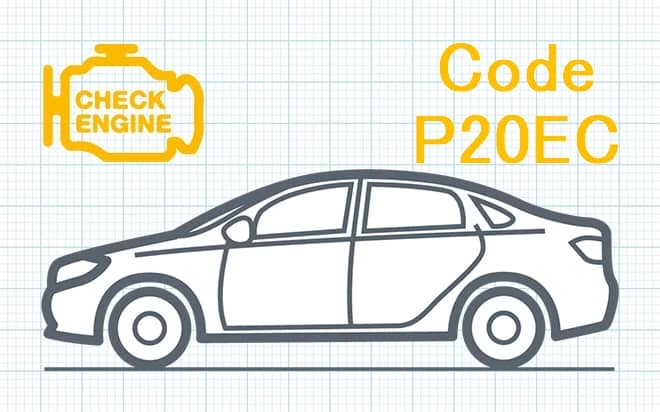
NOx SCR Catalyst P20EC - Superheat Bank 1
Content
- NOx SCR Catalyst P20EC - Superheat Bank 1
- OBD-II DTC Datasheet
- What does this mean?
- What is the severity of this DTC?
- What are some of the symptoms of the code?
- What are some of the common causes for the code?
- What are some P20EC troubleshooting steps?
- Related DTC discussions
- Need more help with the P20EC code?
NOx SCR Catalyst P20EC - Superheat Bank 1
OBD-II DTC Datasheet
SCR NOx Catalyst - Superheat Bank 1
What does this mean?
This is a generic Diagnostic Trouble Code (DTC) applicable to many OBD-II vehicles (1996 and newer). This may include, but is not limited to, Audi, Buick, Chevrolet, Ford, GMC, Mercedes-Benz, Subaru, Toyota, Volkswagen, etc. Although the general repair steps may vary depending on the year of manufacture, make, model and transmission configuration. ...
When the P20EC is stored in an OBD-II equipped diesel vehicle, it means that the powertrain control module has detected that the temperature of the selective catalyst reduction (SCR) system is above the maximum allowed. This particular code applies to the lower temperature sensor for the first row of engines. Bank one is the engine group that contains the number one cylinder.
Although modern clean combustion diesel engines have many advantages over gasoline engines (especially in commercial trucks), they also tend to emit more certain harmful exhaust gases than other engines. The most prominent of these corrosive pollutants are nitrogen oxide (NOx) ions.
Exhaust Gas Recirculation (EGR) systems help dramatically reduce NOx emissions, but many of today's powerful diesel engines cannot meet stringent US federal (US) emission standards using the EGR system alone. For this reason, SCR systems have been developed.
SCR systems inject Diesel Exhaust Fluid (DEF) into the exhaust gases upstream of the catalytic converter or NOx trap. The introduction of DEF raises the temperature of the exhaust gases and allows the catalytic element to operate more efficiently. This extends catalyst life and reduces NOx emissions.
Temperature sensors are placed before and after the catalyst to monitor its temperature and efficiency. The entire SCS system is controlled by either the PCM or a stand-alone controller that communicates with the PCM. Otherwise, the controller monitors the temperature sensors (as well as other inputs) to determine the appropriate timing for the DEF injection. Precision DEF injection is essential to keep the exhaust gas temperature within acceptable parameters and to ensure optimal NOx filtration.
If the PCM detects that the catalyst temperature exceeds the maximum allowable parameters, a P20EC code will be stored and the malfunction indicator lamp may come on.

What is the severity of this DTC?
Any SCR related codes stored can trigger the SCR system to deactivate. A stored P20EC code should be treated as serious and rectified as soon as possible. Failure to correct the code quickly can damage the catalyst.
What are some of the symptoms of the code?
Symptoms of a P20EC trouble code may include:
- Excessive black smoke from vehicle exhaust
- Reduced engine performance
- Decreased fuel efficiency
- Other stored SCR and emission codes
What are some of the common causes for the code?
Reasons for this code may include:
- Defective exhaust gas temperature sensor
- Broken SCR system
- Defective SCR injector
- Incorrect or insufficient DEF fluid
- Bad SCR controller or programming error
- Exhaust leaks in front of the catalyst
- Installation of non-original or high-performance exhaust system components
What are some P20EC troubleshooting steps?
If other SCR or exhaust emission codes or exhaust gas temperature codes are stored, they should be cleared before attempting to diagnose the stored P20EC.
Any exhaust leaks in front of the catalytic converter must be repaired before attempting to diagnose this type of code.
Diagnosing a P20EC code will require access to a diagnostic scanner, digital volt / ohmmeter (DVOM), infrared thermometer with laser pointer, and a source of diagnostic information for your specific SCR system.
Search for a Technical Service Bulletin (TSB) that matches the year of manufacture, make and model of the vehicle; as well as engine displacement, stored codes, and detected symptoms can provide useful diagnostic information.
Begin the diagnosis by visually inspecting the SCR injection system, exhaust gas temperature sensors, NOx sensors, and oxygen sensor harnesses and connectors (02). Burnt or damaged wiring and / or connectors must be repaired or replaced before proceeding.
Then find the car diagnostic connector and plug in the scanner. Retrieve all stored codes and associated freeze frame data and write this information down before clearing codes. Then test drive the vehicle until the PCM enters readiness mode or the code is cleared.
If the PCM does enter ready mode, the code is intermittent and can be much more difficult to diagnose at this time. The conditions that contributed to the persistence of the code may need to worsen before a diagnosis can be made.
If the code resets immediately, search your vehicle information source for diagnostic block diagrams, connector pinouts, connector faces, and component test procedures and specifications. This information will be needed to complete the next steps in your diagnosis.
Observe the data flow of the scanner to compare the data from the exhaust gas temperature sensors (before and after cleaning) between the engine blocks. If discrepancies are found, check the exhaust gas temperature sensors using the DVOM. Sensors that do not meet the manufacturer's specifications should be considered defective.
If all sensors and circuits are working properly, suspect that the catalytic element is defective or that the SCR system is out of order.
- Make sure the DEF reservoir is filled with the correct fluid and is not contaminated in any way.
Related DTC discussions
- There are currently no related topics in our forums. Post a new topic on the forum now.
Need more help with the P20EC code?
If you still need help regarding DTC P20EC, post a question in the comments below this article.
NOTE. This information is provided for informational purposes only. It is not intended to be used as a repair recommendation and we are not responsible for any action you take on any vehicle. All information on this site is protected by copyright.
